Virtual Reality in Mexican Education: A Growing Trend
Virtual reality (VR) is rapidly transforming the education sector, offering immersive and engaging learning experiences. In Mexico, the adoption of VR for educational purposes is steadily increasing, with a growing number of students and educators embracing this innovative technology.
Current Usage Statistics
While precise figures on VR usage in Mexican education are not readily available, several indicators suggest a significant and growing user base. A 2021 study by the National Institute of Statistics and Geography (INEGI) revealed that approximately 12% of Mexican households owned VR devices, highlighting the potential for VR adoption in education. Additionally, several educational institutions in Mexico have begun incorporating VR into their curricula. For instance, the Universidad Nacional Autónoma de México (UNAM) has established a VR laboratory for students to explore virtual environments and simulations. Furthermore, the Tecnológico de Monterrey has partnered with VR technology providers to develop immersive learning experiences for various subjects.
Benefits of VR in Education
VR offers numerous benefits for students and educators alike:
- Enhanced Engagement: VR creates immersive learning environments that capture students’ attention and promote active participation.
- Improved Understanding: VR simulations allow students to visualize complex concepts and interact with them in a realistic manner, leading to deeper understanding.
- Increased Accessibility: VR can provide access to educational experiences that may be geographically or financially inaccessible, such as field trips or laboratory experiments.
- Personalized Learning: VR enables personalized learning experiences tailored to individual student needs and learning styles.
Challenges and Future Prospects
Despite its potential, VR in Mexican education faces certain challenges, including:
- Cost: VR devices and software can be expensive, limiting accessibility for some schools and students.
- Technical Expertise: Implementing and maintaining VR technology requires technical expertise, which may not be readily available in all educational institutions.
- Content Development: High-quality VR educational content is still limited, requiring further investment and development.
However, the future of VR in Mexican education is promising. As technology costs decrease and content development expands, VR is poised to become an increasingly valuable tool for enhancing learning experiences and empowering students with innovative educational opportunities.
Conclusion
The use of virtual reality for educational purposes in Mexico is on the rise, with a growing number of students and educators embracing this technology. While challenges exist, the potential benefits of VR in education are significant, paving the way for a more immersive, engaging, and accessible learning environment for all.

